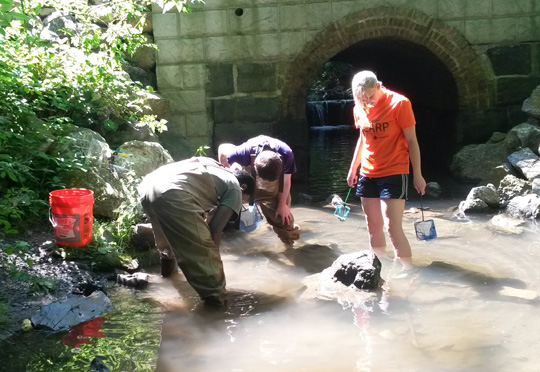Orconectes rusticus is not welcome here. It’s aggressive, overproduces and upsets the balance of Lancaster County aquaculture.
Native to the Ohio River basin and Kentucky, this invasive crayfish species, known for its larger claws and red body dot, wreaks havoc with native populations along the East Coast and in Europe.
“Rusty” likely arrived in the 1960s, sloshing around in bait buckets. When they jumped the hook or unused bait was dumped, they set about reproducing. One female can carry 100 fertilized eggs. Rusty now inhabits the locales in Europe, the Great Lakes Region, areas in New England and spots along the U.S. eastern coast including the nearby Conewago Creek, where Elizabethtown College students, armed with nets and quick hands scoop them up as study subjects.
“In Pennsylvania, everyone seems to have picked up a crayfish,” said Anya Goldina, visiting assistant professor of biology. “The students actually taught me how to find them and pick them up.”
Goldina’s students study these freshwater crustaceans for several reasons, not least of which is to track their use of pheromones—chemicals that affect behavior of others in areas of sexuality, territorial defense and aggression—to determine how they relate on a social level. The studies explore the idea of pheromone baiting for trap efficiency, but there is concern crayfish cannot distinguish between pheromones of other species and their own. If that’s the case, pheromones attracting invasive species, also attract native species.
It’s a live animal the students can pick up and study. It’s fun for them.”
More aggressive, Rusty is better able to compete for food resources and pushes natives from shelter. Rusty also endangers some aquatic plants and fish populations.
Astacology, or the study of crayfish, has been going on for decades, Goldina said, but not always for the role they play in aquaculture. Their “neural systems, responsible for regulating some of their behaviors, are well understood,” said Goldina. “Because of that, scientists have been able to examine how certain neurotransmitters, primarily serotonin, affect complex behaviors. This is not possible to do in humans, whose neural organization is much more complex.”
Crustaceans have been essential in helping science understand how neurons modify complex behaviors such as aggression. So, crayfish and their lobster cousins have been instrumental in helping scientists understand responses to serotonin uptake inhibitors (SSRIs), or antidepressants.
In the Conewago and Conoy creeks, however, it’s their aggression and reproduction habits that are under the microscope, figuratively. Working through a National Oceanic and Atmospheric Administration Pennsylvania Sea grant, the students look to “find ways we can protect watersheds in the area from invasive species,” Goldina said.
“It’s a live animal the students can pick up and study. It’s fun for them.”
Senior bio-secondary education student Carly Egberts began researching crayfish in fall 2016. In addition to the exploration of Rusty’s habits, she also created a teaching unit for her Honors Project, which she hopes to implement while student teaching tenth-graders at Conestoga Valley High School. Egberts designed five teaching models that include study of theories, observation, experimentation, control groups, analysis and data collection.
Students start by using basic observation skills to identify native and invasive crayfish species using a dichotomous key, a tool that allows the user to determine the identity of items in the natural world, she said. The unit then focuses on inquiry-based activities to examine the impacts of invasive species on ecosystems and the traits that allow invasive species to outcompete native species. “These activities include being in charge of a National Park and determining how to fix the various invasive species problems located in their park, as well as researching various traits of invasive species to then create their own species,” Egberts said.
The unit closes by examining antagonistic behavior between Orconectes rusticus crayfish. The students observe two crayfish fighting and score them. “By incorporating the activities developed in this unit, students will develop an understanding about the impacts of invasive species on the environment and biodiversity, as well as the importance of preventing the expansion of invasive species,” she said.
A microscope received as a Christmas gift when she was in sixth grade piqued Egberts interest in biology she said. And, though she started at Elizabethtown in biotech, she found her home in the Education Department, teaching students about the amount of research that can be done with something you find in a creek.


